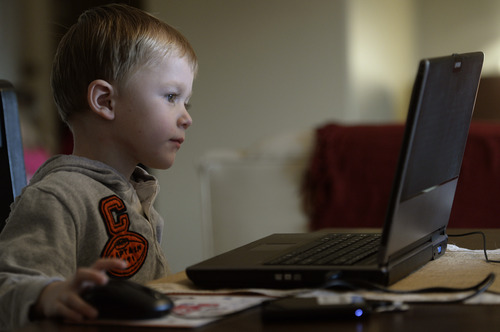This is an archived article that was published on sltrib.com in 2014, and information in the article may be outdated. It is provided only for personal research purposes and may not be reprinted.
Children as young as 3 or 4 can benefit greatly from technology, but educators have been slow to adopt digital devices in preschool classrooms, a U.S. Department of Education deputy secretary said Tuesday in Salt Lake City.
Libby Doggett, who heads up the Obama administration's early-childhood education office, spent the day touring Granite School District's innovative preschool program and spoke at an event sponsored in the afternoon by the Waterford Institute.
That Sandy-based nonprofit developed UPSTART, a software program that allows preschoolers to get ready for school via a computer at home. About 1,500 children are in the program this year, its fifth. Computers are loaned to low-income families.
Next year, however, some 5,000 families will be served because the Utah Legislature just approved $3 million more for UPSTART, bringing total funding to $4.7 million per year, said Claudia Miner, vice president of development for Waterford.
Waterford also has been awarded a $11.5 million federal research grant to provide UPSTART to 1,700 children in 18 rural Utah districts; those children will use the program during the summers after kindergarten, first and second grades as well as before kindergarten.
Doggett said UPSTART is the kind of program the country needs more of — and may get if Congress funds President Barack Obama's ConnectEd initiative, launched last year to improve access to high-speed Internet and gadgets in schools.
Already, private companies have pledged $750 million in technology donations, and the Federal Communications Commission has said it will put $2 billion (collected from industry surcharges) into high-speed access in schools and libraries.
"We need to make sure early learning is included," said Doggett, a former preschool teacher in Texas.
Tablets, computers, smart phones and Mp3 players — coupled with good software — can teach children to solve problems and can satisfy the appetite children naturally have for learning, she said.
They can learn, too, from their own creativity using devices.
"Devices not only bring the world to our students … . They can bring what children create to the world."
High-quality literacy applications, with word pronunciations and definitions handy, help children learn to read. "Kids like to re-read and engage with stories over and over again," she said.
Research also shows that technology can help with executive skills such as collaboration, patience and cooperation with peers.
Doggett used the example of her 6-year-old granddaughter, Clara, who at age 4 was faster than her MIT-educated father at putting U.S. states on an iPad program's map.
That led to Clara's interest in other technology and learning in general, Doggett said. For instance, last summer, she lugged a library book about license plates on vacation and spent her time identifying plates on the roadway.
"That's for a kid who was not yet in kindergarten. Now she's interested in maps, the globe and wants to hear about different countries."
Doggett said that one of the most important ways educators can use technology is to communicate with parents, she said.
Yet schools throughout the country need more models for how technology can be used — and to know which device and software are useful.
Salt Lake County Mayor Ben McAdams, who last summer persuaded the County Council to put money into Granite's preschool program, was among those attending Doggett's speech.
Twitter: @KristenMoulton



